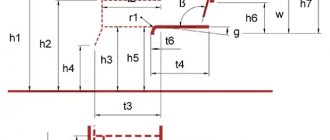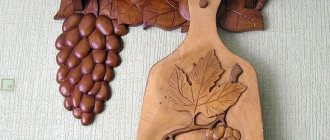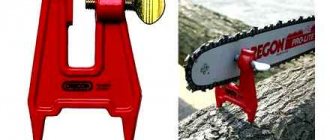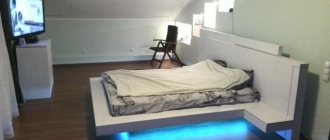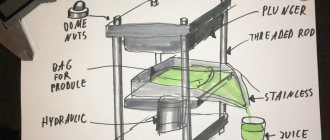The kitchen is one of the most important rooms in any residential home. For greater convenience, you can place a kitchen cabinet or buffet in it, including one made by yourself. A sideboard is a cabinet with shelves and a closed lower compartment; it is not just another set of additional shelves, but a whole design and practical solution for the kitchen. The modern market offers many options for buffets to choose from, but it is still difficult to choose the right size and suitable design, so kitchen cupboards are often assembled with your own hands.
How to make a wooden buffet with your own hands
Such functional furniture stands out among purchased ones: you have the opportunity to choose the material and texture yourself, choose the right color, design and look, and make a sideboard that is ideal and fits into the overall style of the kitchen. Another advantage is the ability to make a buffet that fits perfectly in size, while purchased furniture cannot offer a variety of sizes.
Important! To decorate a new sideboard, you can use various styles: painting in an unusual color, modeling, unusual glass. For the upper open part, it is better to choose beautiful dishes, and hide pots and pans in the lower drawer.
The buffet will fit well into any interior. It can be an antique sideboard, with carvings and made of real wood, or modern sideboards in a strict and laconic form.
Materials and tools
The variety of modern building materials allows you to choose any convenient material, based on financial capabilities and personal preferences. The most popular ones in our work are:
Fiberboard
The material is resistant to high humidity, durable, affordable and relatively easy to process. Mainly used for the back walls of cabinets, wall cabinets and drawers, without deformation and securely held on fasteners. The simplicity of this material allows you to experiment with it, and its lightness allows you to reduce the weight of the finished buffet.
Chipboard
Comfortable material with a variety of patterns on the surface is widely used for making furniture. It is quite durable, lightweight and easy to work with, strong and, thanks to its structure, repels water. It is easy to work with, it holds the cut shape well and is convenient when cutting and assembling, holding nails well. However, finished furniture should not be installed near heat sources. Otherwise, the release of harmful substances from the compressed resin into the air can lead to allergies and diseases.
MDF
The widespread use of this environmentally friendly material is due to its advantages: moisture resistance, beautiful structure. The principle of its creation is similar to chipboard, but it is made from higher quality materials and is not afraid of being near heat. The only drawback is the relatively high price. MDF holds its shape well and can be used to create decorative elements.
Wood massif
An ideal material for creating such furniture. It is environmentally friendly, and the properties can vary due to the choice of different types of wood, which also differ in physical properties. Pine, larch or oak are best suited for a buffet. Natural wood looks much better, but the cost will be comparatively higher. To save money, you can assemble a sideboard using various materials and use wood for the front parts, and create shelves and the back wall from cheaper analogues.
In addition to the material for cutting, you will need a set of tools. There are no special mechanisms or devices here; everyone can find them:
- drill;
- screwdriver;
- wood drills;
- roulette;
- duct tape;
- pencil for drawing;
- vice;
- Grinder;
- milling machine;
- sanded sheet;
- varnish coating;
- drawing.
The drawing is prepared in advance and contains all the necessary dimensions, number of units, thickness of all materials and their quantity. The drawing allows you to calculate everything in advance and purchase the required number of sheets and cuts.
How to take measurements correctly
To ensure that upon completion of the work there are no excess materials left or, on the contrary, a shortage is not discovered, all necessary measurements and initial calculations are carried out before work. To do this, use a drawing calculating the height and width of the product and all elements: shelves, doors, etc.
- Sketching a kitchen wall or corner on a sheet of paper will always allow you to keep before your eyes an image that can be considered three-dimensional. It is also necessary to sketch out all the elements located there: sockets, pipes, other furniture that cannot be moved.
- Carefully measure all possible distances and record them in the drawing: the ceiling may not be perfectly flat, so height measurements must be taken in at least two places. The desired depth of the chest of drawers is noted with additional consideration for the thickness of the doors and back wall. The height of the chest of drawers should take into account the fact that when installing it, it will be necessary to raise it and not damage the ceiling.
- At this stage, the calculation of the opening of the doors, the dimensions of the protruding parts of the decoration and the height of the chest of drawers are carried out. Control measurements of the chest of drawers are applied to the drawing and a general check is made: the chest of drawers must take into account the height of the ceiling, should not cover the window and, when using chipboard, should not be located next to the radiator.
Important! Measurements should be recorded in millimeters.
Schemes and drawings
Although most kitchens are made according to a standard design, the cabinet will still have to be made according to individual parameters. After all, in each apartment the location of large equipment and communication outlets may differ.
p, blockquote 14,0,0,0,0 —>
Also, when drawing up a drawing of a buffet with dimensions, you need to take into account a number of points:
p, blockquote 15,0,0,0,0 —>
- thickness and dimensions of the sheet. Perhaps by removing some of the trim or making some of the shelves open, you can significantly save on materials (spending one less sheet). You also need to take into account the clearance for allowances and grinding;
p, blockquote 16,0,0,0,0 —>
- filling of the finished product. It is better to select the height of the shelves for specific utensils and household appliances. With the same consideration, the dimensions of the drawers and the final dimensions of the buffet are calculated;
- cabinet location. Hinged doors must open completely. At the same time, it is desirable that they do not block the passage and do not hit walls or adjacent pieces of furniture. Do not install the buffet too close to the sink and stove. Splashes and fumes will significantly reduce the service life of the product.
p, blockquote 17,0,0,0,0 —>
The drawing is drawn up in three stages:
p, blockquote 18,0,0,0,0 —>
- A room plan is drawn indicating the location of the rest of the furniture, equipment and communications (sockets, switches, pipes, etc.).
- A diagram of the finished buffet with all dimensions is drawn up (view from the outside and inside). At this stage, it is necessary to think through all the joints, ends and fastenings.
- According to the drawing, a complete list of required blanks with dimensions is compiled. All parts must be numbered, the required number of specific elements, fasteners, and fittings must be indicated.
This approach will facilitate the manufacturing process and help avoid possible errors.
p, blockquote 19,0,0,0,0 —>
Buffet yourself: step-by-step instructions
After taking all the necessary measurements and cutting, the buffet is assembled in the following order:
- Preparation of large elements: marking the side walls, rear wall, bottom, etc. At this point, all parameters according to the drawing are taken into account.
- Preparing smaller parts of the sideboard, preparing side parts for fastening, holes for assembly, connecting partitions and main parts using fasteners.
- Mounting the housing and installing the internal parts using screws and angles, assembling the base parts according to the drawing.
- Placement of the façade slab with projections for the doors and back panel.
- The back wall is assembled, the canvas is fixed at the back and for convenience the finished buffet can be laid on its side.
- Installation of hanging parts: hinges, doors, additional design elements.
- Installing furniture in its place and checking the overall assembly for quality of installation.
- Decoration: installation of door handles, coating or decoupage.
Important! Professionals advise using a depth limiter, this will prevent you from damaging the wall by drilling through it.
Important! For convenience and to avoid errors, it is recommended to number and mark the parts.
Assembling a buffet at home is not as difficult as it might seem at first glance. Careful measurements, selection of materials and arrangement of the workplace will help you create a homemade piece of furniture that fits perfectly into the interior.
What is a buffet? In the old days, this was the name for small rooms near the kitchen where food was kept. Today it is a kind of cabinet with shelves for storing beautiful clay pots, painted dishes, wine glasses and other decorative kitchen utensils. All these details “domesticate” the interior, adding a touch of comfort, warmth and originality to it. Therefore, we decided to devote our article specifically to buffets.
Nice compact model
What types of kitchen buffets are there?
In the classical sense, a buffet is a rather massive closed cabinet located on the floor, and on top of it is a cabinet with glass doors.
However, here it is necessary to clarify that doors can be of two types:
- Completely transparent, displaying all kitchen utensils, which are neatly arranged on shelves;
- With a small transparent window through which only part of the entire contents of the buffet is visible.
A very unusual model with small windows
There can also be an open countertop between the top and bottom. Frequently used items, vases with fruits or flowers, and all kinds of figurines are most often displayed on it.
Note the built-in countertop
Based on shape and size, the buffet can also be divided into several types. But the most optimal of them is a two- or three-door cabinet with a glass display case. Lots of convenient drawers, shelves, and an open display case – very functional.
Advice! The lower closed cabinet can easily accommodate large kitchen utensils (pans, jugs, pots, wide dishes) and even small household appliances (steamer, blender, bread maker). And in the upper showcase you can put decorative items, for example, an expensive tea set.
True, such a buffet requires quite a lot of space, so it is unlikely to be suitable for small kitchens. The approximate dimensions of this beauty are: width from 120 to 200 cm, height about 200 cm, and depth about 45 cm.
However, there are also buffets that are more modest in size; they are lower and not so deep. You can also fit a corner model of a sideboard into a compact and harmonious design. It has a semicircular shape and fits perfectly into a corner without interfering with free movement around the kitchen.
Compact buffet for a small kitchen
Where to place a display buffet in the living room
A display buffet is usually located in the center of the living room or next to the dining group. This arrangement of furniture is especially relevant for large, spacious houses. Furniture manufacturers specially produce entire series, which usually include a dining set, two display cupboards, and a chest of drawers with a mirror.
In a small apartment, a sideboard or a “slide” would be appropriate, rather serving a decorative function. Souvenirs and art objects displayed in it will be better visible if the cabinet is illuminated by sunlight or artificially illuminated.
A display buffet or sideboard can become a room zoning tool, separating the dining room from the relaxation area. Two corner cupboards at the edges of the living room will fit harmoniously into the interior if there is a chest of drawers, a fireplace or a TV stand between them.
Where is the best place to put a buffet?
Here are some instructions, or rather recommendations, on this matter from professional designers:
- If your kitchen is spacious, then the dining buffet will look harmonious near the dining area near the table or opposite the entrance to the kitchen. In this case, the guests’ attention will immediately fall on the original sideboard with beautiful dishes or other decorations.
- If you have a separate dining room, then, of course, it is better to place a large buffet there.
Placing a buffet in the dining room
- For studio apartments, a so-called buffet bar is suitable. It can become a kind of space delimiter. With its help, you can successfully divide the room into a cooking area and a living room. In addition, with such furniture, you will not have to break away from the conversation during the cooking process, and prepared dishes and drinks can be served directly through the buffet.
- But even if you have an apartment with a small kitchen space, you don’t need to deny yourself the pleasure of installing such beauty. A sideboard can be used to “fill” a non-functional niche in the wall or a dead “dead corner”, as you can see in the photo below.
Buffet formats
Before you open your buffet from scratch, you need to decide on its format. They are conventionally divided into morning, lunch and evening - according to peak load time. Theoretically, a small establishment selling simple food can be located anywhere: in a school or business center, in a football or hockey arena, in a hospital or factory, in a hotel or in court. However, some formats are most popular due to their profitability and prevalence.
Type: Restaurant (dining room)
Features: In large catering establishments, you can open a small buffet. It is designed for those who want to quickly have a snack or buy groceries at a lower price. In this case, several issues are resolved: there is no need to look for a supplier of products, or additionally organize cleaning of the premises.
Type: Student (school)
Features: An establishment of this type does not have the right to sell alcohol, and the sale of dishes and snacks, as a rule, is carried out using disposable tableware. Schools do not encourage the sale of potentially unhealthy food (chips, popcorn, sweet soda). Students need vigor and health to work productively, therefore, in addition to hot food, it is recommended to replenish the assortment with fresh vegetables and fruits, and energy bars.
When opening, you should take into account the height of visitors: the counter for paying the bartender and receiving the order should not be too high. Students away from home mostly have lunch or a small snack, which needs to be kept in mind when preparing the menu
The highest flow of visitors is achieved at lunchtime, it is important to organize very fast service
Type: Office (in a business center)
Features: An adult, solvent and discerning audience has appropriate service requirements. To be popular, a catering facility must have an impressive assortment and conditions for eating food (not only a counter, but also normal tables and chairs)
It is important to create an attractive design of the establishment and strictly adhere to the dress code for the seller
In the office buffet, visitors mainly have breakfast, go for lunch (work break), and have lunch much less often (if there are enough canteens, cafes and restaurants in the vicinity). It is necessary to create conditions for the sale of takeaway hot drinks and alcohol, which is extremely in demand in the business environment.
Type: Hospital (outpatient)
Features: In health institutions there is also a high need for catering establishments. The facility does not have to rely on the sale of alcohol and cigarettes, which is due to the specific location
It is important to ensure high sterility: the presence of disposable tableware, frequent wet cleaning of tables, counters, floors, a wide range of packaged food products
In a hospital or clinic, the buffet is mainly used for snacks; it is unwise to rely on hot breakfasts, lunches and dinners
Taking into account the characteristics of a healthcare institution, it is important to adjust work (for example, from 7 or 8 a.m. to evening)
In addition, there are buffets in theaters, industrial enterprises, and government agencies. However, establishments of this type suffer from excessively low occupancy (for example, only on days when productions are shown and only at certain hours), and rarely demonstrate high profits. But if it is possible to create a catering outlet that can accept customers “from the street” (that is, through a window for dispensing goods), then it makes sense to consider theaters, enterprises or government agencies as a platform for business.
How to fit a buffet into the overall kitchen interior
Of course, the most popular models are the traditional “old-fashioned” sideboards, made of noble wood with stunning engravings, carvings and balustrades on the facades, cornices, and plinths. Such models have an aristocratic appearance and are perfect for the classic style of kitchen interior.
Large model made of noble solid wood
For a country-style kitchen, it is better to choose a rustic sideboard made of untreated wood, without elegant finishing, with numerous pull-out, lockable cabinets, or curtained with fabric in small flowers. But the Provence style will approve of white buffets with open shelves.
Provence style
As for modern kitchen interiors, there are suitable models for them too. Laconic forms and rigor are what characterize buffets of our time. And, it should be noted, they are made not only from wood, but also from plastic, acrylic, frosted glass, and decorations achieved using new technologies.
More modern model
Buffet for the kitchen in Provence style
Provence is unity with nature, soft waves of the sea, gentle sun, endless fields of lavender with a charming aroma, clean air. Provence is a style that combines elegance, comfort and simplicity, which has several features:
- soft shades;
- use of natural materials;
- direction for “antiques”;
- emphasis on detail.
Elegance and lightness fit into a style with a wide range of convenience. Provencal interior design is based on comfort and simplicity, and the unobtrusiveness of the lines allows you to enjoy the furniture for a long time without any desire to change the situation. This used sideboard for dishes meets all the criteria of the Provence style, the main material is a solid board made of natural wood. Maple, linden and moisture-resistant plywood 18 mm thick were used for production. The design of the sideboard is made in an antique style, although the frame turned out to be massive and complex, but in full compliance with the style. You can read the manufacturing instructions on the website, and below see the master class on assembling a buffet in the Provence style with detailed step-by-step photos.
Author: Vadim Portnov Photo source: www.dd-space.com/2014/01/provance-bufet.html#more
Buffet finishing
Probably, many will agree that the new furniture looks impeccable, but, alas, the price is not at all pleasing. If you suddenly inherited your grandmother's sideboard, consider yourself lucky! After all, as you know, furniture used to be made for work, with the expectation of long-term use. And you can bring it into the proper, and most importantly, desired, form yourself, without spending a lot of money on it.
Five ideas for decorating old furniture
We offer you several interesting options for remodeling kitchen furniture.
Even at home, a kitchen buffet with your own hands can be transformed from seemingly shabby furniture into a real interior decoration!
- Painting and replacement of kitchen facades. An old wooden or painted surface must be thoroughly cleaned of grease stains and dust, washed with warm water and detergent and dried. Next, a light sanding with fine-grit sandpaper will be required. If there are cracks in the furniture, we fill them with a special wood putty. The already dried surface must be re-treated with sandpaper (only with medium-grain sandpaper). This is followed by a primer with universal paint and light sanding.
Snow-white cabinets with replaced doors and fittings
Then you need to apply the selected paint in two layers. The cabinets in the photo above are painted white, and some of the doors have been replaced with new glass ones. New metal fittings were also selected. Beautiful dishes complement the overall composition.
Attention! Instead of replacing the doors, you can add a beautiful design to the old doors.
With application of ornament
- Decoupage technique. Here you will only need special napkins or a pre-printed design, scissors, brushes, glue and acrylic. With a little imagination and effort, you will get a truly original and spectacular thing!
Stunning buffet decoupage! And all this with your own hands
- In this version, the cabinets are painted in a delicate light green color, and a colored stencil is applied to the doors. You can experiment with any shades!
With stencil application
- Bright furniture! All with just paint, new fittings and charming curtains. You might like this option.
A kitchen that plays with bright colors is amazing!
- Black and white contrasting furniture. Quite an interesting solution for modern kitchen interiors in high-tech, art deco, minimalism or modern style. And all unnecessary decorations from cabinets in the form of carvings and balustrades can always be removed.
We create it ourselves
If you don’t have a suitable old piece of furniture, but you are eager to create, don’t despair, there are many techniques for creating a buffet with your own hands.
Made from wood and other materials
Since hand-made is now in fashion, on the Internet you can find many master classes on creating sideboards, chests of drawers, tables and other furniture with your own hands.
- So, for example, you can create a buffet from clapboard. This material is usually not used in the manufacture of factory furniture, but it is easy to process, and therefore is excellent for a homemade sideboard. In addition, the lining resists moisture and temperature changes well. In this version of the sideboard, bars for window frames are used as a frame. The drawer is made of plywood, and the front panels are covered with veneer.
- You can make a buffet with your own hands from wood. Of course, this will require more solid skills and close familiarity with carpentry tools. The lower part of a wooden sideboard is usually held together with pegs and glue. The back part and drawers are held on with screws, and other planks and horizontal surfaces are attached with glue and nails.
- Quite often, sideboards are made from chipboard and MDF.
The technology for making a buffet can be divided into several stages:
- Project development. Before starting work, you need to create a drawing of the future sideboard. This piece of furniture usually includes the following components:
- The body, that is, the lower part of the sideboard, represented by the tabletop, sides and back;
- Top box;
- Shelves;
- Box;
- Doors;
- Fastenings and handles.
- Manufacturing of parts. If you do not have sufficient skills, the components of the buffet designed by you can be ordered from the workshop. Having decided to create a sideboard yourself, in addition to the material, you will need a number of tools, in particular, a jigsaw and a circular saw. Having made the frame, you can supplement it with purchased doors. This solution is appropriate when the material for the buffet is chipboard or MDF;
- Assembling finished parts together. Here you will need a screwdriver (or drill) and fasteners. The assembly is performed in the following sequence:
- Creating a frame;
- Attaching backdrops to the frame;
- Hanging the upper part of the sideboard and installing supports, which can be decorative balusters;
- Installation of shelves;
- Door fastening.
- Finishing. After the buffet is assembled, we begin decorating. Glass and mirrors are inserted, cornices and trims are added, crystal and dishes are displayed.
DIY Asian style sideboard
In Provence style and more
Of course, only a professional carpenter can create a full-fledged classic buffet with his own hands. In addition, such a product will require expensive wood, glass and various metal decorations.
It is much easier to create a sideboard or buffet with your own hands in one of the rustic styles, for example, Provence or country. The materials used in such interior items are cheaper, and the finishing on them is much simpler.
- A rustic buffet should be practical, which means it should have drawers, closed and open shelves. The tone chosen for it is light (white in Provence and natural wood colors in country).
- Aiming at country, the wood is not painted, but carefully sanded and varnished.
- Sideboards in the Provence style are created by artificially aging the wood using white paint, and then complemented with patterns, among which small flowers predominate. The easiest way to recreate the French provincial style is to use the decoupage technique.
- Minimalist styles (high-tech, Scandinavian) are unlikely to need a buffet. Here, greater preference is given to wardrobes, niches and shelves.
- A sideboard in the Rococo style, like other furniture, should be turned and carved. However, even if your buffet is devoid of openwork, you can add some decorative elements to it yourself to get closer to the desired style.
So, curlicue painting, asymmetrical overlays made of bronze and copper, and plastic inserts imitating gilded metal will come to the rescue. You can purchase fancy door handles. If it is possible to make a replacement, match the curved legs to the buffet.
A buffet in an English interior is trendy. Here he acts as the custodian of not only porcelain dishes, but also the owner’s library. Such a sideboard should be made in darker and richer colors.
Photos of old sideboards and cupboards after restoration with your own hands
The benefits of making it yourself
If a home craftsman is comfortable with carpentry tools, it will not be difficult for him to please the housewife and make a buffet with his own hands, which is necessary in any kitchen.
For maximum convenience and comfort, you should equip it with not only beautiful, but also functional furniture, such as a buffet.
An excellent solution for any home is to install a corner kitchen cabinet.
A self-made kitchen cabinet has a number of advantages over its “store-bought brothers”:
- you can choose a unique design for it;
- choose the material to your liking;
- use original fittings;
- choose the color scheme of the buffet that best matches the kitchen interior.
To make the interior original, you can make it yourself, putting your soul into the work, using any materials.
The most important nuance when installing such a cabinet is calculating the trajectory of the door opening.
In addition, wood products are extremely beneficial for health: they do not contain toxic compounds and do not emit harmful substances, but they fill the room with the aromas of essential oils.
Sideboards and buffets for the kitchen do not have much difference and are very similar in appearance to each other, because... The ancestor of both is considered to be the closet.
A kitchen buffet is an excellent solution for your kitchen interior.
A wooden sideboard is durable and comfortable. It will last for decades and is easy to restore and repair.
A sideboard made of natural wood will look rich and elegant, but at the same time it will cost a much larger amount.
Another important advantage of making a kitchen cabinet with your own hands is the ability to make it in an original configuration and size that best suits convenience and comfort.
To get a beautiful product without spending too much, you can make the furniture body from cheaper raw materials, such as chipboard, and the facades from more expensive and beautiful ones.
Criterias of choice
Before you begin manufacturing, you need to select a model and suitable material for the future buffet. When choosing, you need to proceed from several factors:
p, blockquote 6,0,0,0,0 —>
- availability of tools. There is no point in buying expensive milling machines, etc. just for the sake of one cabinet. Otherwise, it will be cheaper to order a buffet according to your own design from professionals. In this case, it is better to choose simple models made of MDF and plywood without complex panels and finishing;
p, blockquote 7,0,0,0,0 —>
- own level. It is better for an inexperienced master to choose the simplest scheme. So the likelihood of making a mistake and spoiling the material is minimal;
- use of the finished product. A cupboard can be placed not only in the kitchen, but also in the living room, dining room, or even in an unheated country house. In the first case, it is advisable to make a buffet from wood. Natural solid wood better tolerates the warm and humid microclimate of the kitchen and will last longer than its MDF counterpart;
Deciding on design and construction
Making your own kitchen cupboard opens up a wide field for the imagination of the home craftsman. He can make it, in accordance with his vision and ideas, in various styles:
Modern buffets for the kitchen can be made, guided by a step-by-step description of this process.
Cabinet designs can also be very diverse, including corner and round.
All homemade products radiate the coziness and warmth with which it was made.
Necessary materials
In the friendly family of kitchen furniture, the sideboard occupies a special place - it reigns in the kitchen and bears the features of an elegant sideboard and an ordinary cupboard. Previously, furniture was made “to last,” so the most durable and high-quality wood, well-seasoned and processed, was chosen for its manufacture.
This furniture option is practical, beautiful and takes up little space.
Today's offer of building materials allows you to choose the necessary option for making a buffet with your own hands. But one of the most popular bases for kitchen furniture has become MDF, fiberboard, chipboard and solid wood. The latter does not require additional characteristics, being distinguished by strength, durability, and beauty. As for wood boards, each of them has its own effective properties and disadvantages.
- Fibreboard is resistant to moisture and temperature changes. It is light, strong, durable, affordable and not difficult to process. A buffet made from this material can be quickly assembled. It can be made functional and visually attractive. Most often, such plates are used to install the back walls of wall cabinets, drawers and shelves.
- Chipboard is available in a variety of colors. This is a durable and inexpensive material from which you can make a comfortable, spacious and original cabinet that can easily fit into any kitchen interior. Among the significant disadvantages are emissions of formaldehyde into the air. To reduce their harmful effects on human health, it is necessary to place furniture made from chipboard away from heat sources.
- MDF is used quite widely today. It is manufactured using modern technologies, therefore it is an environmentally friendly material. It has high moisture resistance, which makes it more suitable for use in the kitchen. It has a soft, easily processed structure, which allows it to be used to create a variety of decor for furniture fronts of buffets and to give products a variety of shapes. The only drawback is the fairly high price compared to the cost of chipboard.
- Solid wood is a special chic and a demonstration of high taste. Environmentally friendly, natural material.
This means that you will simultaneously receive moral pleasure from the work done, even if it seems somewhat labor-intensive to you.
The following tree species are most often used to make buffets:
- pine, durable and easy to process;
- larch, strong and not subject to the destructive effects of moisture;
- oak, practically eternal, does not rot and does not require varnishing.
Kitchen cabinets can only be appreciated by true connoisseurs of beauty and art.
Depending on the place where the hand-made buffet will be installed, you can use different materials. For a dacha or summer kitchen, you can make a kitchen cabinet made of plastic, simple in design and inexpensive.
After all, with the help of this product you will be able to restore order in this part of the house, and it will become the “highlight” of the interior.
An original sideboard in a mansion kitchen, made of MDF or solid wood, with unusual shelves and niches, will look expensive and presentable.
Today, a buffet is a kitchen cabinet, which is completely closed at the bottom, and its upper part is made in the form of a display case.
Tree selection
Breeds for making furniture are divided into three categories:
Let's look at the advantages and disadvantages of some types of wood.
Pine
The structure of this wood is soft, so it is easy to cut, saw, surface planer, glue and paint. Pine can withstand high humidity conditions. Furniture made from it exudes a subtle pine smell and phytoncides, which destroy harmful microorganisms in the kitchen atmosphere.
Unfortunately, pine is susceptible to scratches and chips with slight mechanical impact on its surface. The service life of pine furniture can be a couple of decades. In hot conditions, wood releases resin, which can significantly deteriorate the appearance of the cabinet.
The most expensive and durable type of hardwood. The saw cut may be light or yellow-brown in color. An oak sideboard will decorate the most sophisticated interior. The surface of the furniture is varnished to highlight the beauty of the wood structure.
Oak is a durable, wear-resistant material that is not subject to rotting and can withstand sudden temperature changes. Oak furniture can last for centuries.
The main disadvantage is the high price.
Also applies to valuable wood species. The saw cut has a beautiful texture. The older the material, the darker its structure. Walnut lends itself well to processing. Various elements of furniture decor are cut from it. Walnut furniture is valued for its high performance and beauty.
Walnut is a rare material on the timber market and is expensive.
Birch
The cut of this timber has a beautiful soft light color. Furniture made from it has a dense structure. Birch veneer is used to decorate wardrobes and desks.
Wood is susceptible to rotting and can become deformed due to sudden temperature changes.
Yew, boxwood
Rare and expensive wood species. They are used to make parts for decorating the facades of furniture made from cheaper species.
Required Tools
To make a kitchen buffet to your liking, you will need an individual set of tools, but among them there are those that you cannot do without, regardless of what material, design and configuration of the product the master chooses.
In the classic version, there are work surfaces. This part is always decorated with decorative elements.
- drill;
- wood drills;
- jigsaw;
- a circular saw;
- Sander;
- screwdriver
and other tools and devices that should be at hand.
The most common are closed cabinets.
Instructions for making a corner sideboard
The corner of the room is often left empty. If there is a shortage of usable space in the kitchen or living room, a corner cabinet will provide greater freedom.
Prepare your tools. In principle, the list is the same as described in the previous case, only we don’t need clamps.
Select the following materials:
- boards 290 mm wide and 12 mm thick;
- plywood 8 mm thick;
- dowels - wooden dowels;
- wood glue;
- stain;
- furniture or water-soluble varnish;
- self-tapping screws;
- furniture handles and hinges;
- ruler, tape measure, pencil or marker;
- sandpaper.
Manufacturing process: step-by-step instructions
Before you take up the tools, you need to clearly imagine what kind of buffet you will make, and reflect your thoughts and ideas on the drawing, indicating all the details of the product.
A sideboard is part of the kitchen furniture.
First, the largest elements of the product that form its basis are prepared according to the available drawings, taking into account the necessary parameters. In order not to disturb the assembly order and not to lose the necessary parts, experienced home craftsmen advise numbering all parts.
It has the shape of an ordinary cabinet with a closed and an open part.
After completing the preparatory work, the cabinet is assembled in the following order.
- Preparing the side parts of the furniture, drilling holes in them. It is worth paying attention to the advice of experienced craftsmen who recommend using a depth limiter to control the distance between the recesses. Its use allows you to protect furniture parts from through drilling.
- Connection of buffet partitions
- Connection of the upper part of the product and the outer side parts. The top of the product is located on the end fasteners, and the side parts and bottom are pushed all the way.
- Installation of internal parts. First, the buffet body is mounted on the rear ends. Screws are used to secure the lower part, and mounting angles are used to connect it to the upper part.
- Assembly of base parts and their fastening. To mark the plinth, a drawing of kitchen furniture is used, according to which the panels are fixed on bars located at the corners of the structure.
- Decoration of the façade. The plate is placed in its place, and protrusions of the required size are left on the sides. They are needed for hanging doors and fixing the back panel.
- Securing the back wall. The sideboard body is laid out on its side to secure the canvas in the required position.
- Installation of doors and hinges. The left and right doors, the bottom and the top are marked with marks, after which the hinges are installed according to the marked marks. The cabinet doors are mounted in place, securely fastened on the hinges.
- Installing furniture in its permanent place, installing shelves and drawers, checking the quality of installation and ease of use of the product.
The designs of such cabinets vary.
However, in other designs you can also find kitchen furniture with engravings, plinths and cornices on the facades.
Buffet decoration
The final stage of making a unique kitchen cabinet, made by yourself, will be its decoration. Here can be used:
- ready-made fittings;
- handmade wooden or metal decorative items;
- ornaments and colored decoupage images;
- photographs, glass and plastic decorations;
- original decorative products, made by hand or to order, depending on the style of the product.
To assemble furniture you will need a lot of space, so before you make a cupboard with your own hands, you need to take care of the free space.
Due to decorative elements and the use of natural materials, cabinets are most often used in a classic style.

